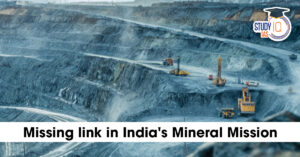Daily Quiz 05 August 2025
Quiz-summary
0 of 5 questions completed
Questions:
- 1
- 2
- 3
- 4
- 5
Information
- Click on – ‘Start Quiz’ button
- Solve Questions
- Click on ‘Next’ button
- Click on ‘Finish Quiz’ button
- Now click on ‘View Questions’ button – here you will see solutions and links.
- The test contains a total of 5 questions.
- Click on the most appropriate option to mark it as your answer.
- You will be awarded Two marks for each correct answer.
- You can change your answer by clicking on some other option.
- A Number list of all questions appears at the top side of the screen.
- You can access the questions in any order by clicking on the question number given on the number list.
- You can use rough sheets while taking the test.
- Do not use calculators, log tables, dictionaries, or any other printed/online reference material during the test.
- Do not click the button “Finish Quiz” before completing the test. A test once submitted cannot be resumed.
You have already completed the quiz before. Hence you can not start it again.
Quiz is loading...
You must sign in or sign up to start the quiz.
You have to finish following quiz, to start this quiz:
- 1
- 2
- 3
- 4
- 5
- Answered
- Review
-
Question 1 of 5
1. Question
1 pointsConsider the following statements with reference to India’s Free Trade Agreements (FTAs):
- Under the India–UAE CEPA, over 90% of Indian exports are duty-free.
- India’s FTA with Australia provides full duty-free access to all Indian exports.
- India withdrew from RCEP to protect its economy from Chinese imports.
Which of the statements given above is/are correct?
Correct
Answer: C
Explanation:
- Statement 1 is correct: The India–UAE CEPA (signed in 2022) ensures that 90% of Indian exports enter the UAE market duty-free, benefiting key sectors like gems and jewellery, textiles, and pharma.
- Statement 2 is incorrect: India’s Economic Cooperation and Trade Agreement (ECTA) with Australia does not provide full duty-free access to all exports. It covers about 96% of Indian exports, with some sensitive sectors excluded.
Statement 3 is correct: India withdrew from the Regional Comprehensive Economic Partnership (RCEP) in 2019, largely due to concerns over a potential flood of cheap Chinese goods, threatening domestic industries and the trade deficit.
Incorrect
Answer: C
Explanation:
- Statement 1 is correct: The India–UAE CEPA (signed in 2022) ensures that 90% of Indian exports enter the UAE market duty-free, benefiting key sectors like gems and jewellery, textiles, and pharma.
- Statement 2 is incorrect: India’s Economic Cooperation and Trade Agreement (ECTA) with Australia does not provide full duty-free access to all exports. It covers about 96% of Indian exports, with some sensitive sectors excluded.
Statement 3 is correct: India withdrew from the Regional Comprehensive Economic Partnership (RCEP) in 2019, largely due to concerns over a potential flood of cheap Chinese goods, threatening domestic industries and the trade deficit.
-
Question 2 of 5
2. Question
1 points. With reference to Startup20, consider the following statements:
- It was first launched during the Indonesian G20 Presidency.
- It aims to include startups in the global policy-making process.
- It functions as an alternative to the Business20 (B20) group.
Which of the statements given above is/are correct?
Correct
Answer: C
Explanation:
- Statement 1 – Incorrect: Startup20 was launched under India’s G20 Presidency in 2023, not Indonesia’s. While countries like Turkey and Indonesia contributed to the momentum, India formalized it as an official G20 Engagement Group.
- Statement 2 – Correct: Startup20 aims to give startups, innovators, and early-stage ventures a seat at the global policy-making table, which was earlier dominated by large businesses through Business20 (B20).
Statement 3 – Correct: Startup20 is not a complete replacement for B20 but acts as a complementary platform, ensuring the voice of startups and SMEs in global economic policy discussions.
Incorrect
Answer: C
Explanation:
- Statement 1 – Incorrect: Startup20 was launched under India’s G20 Presidency in 2023, not Indonesia’s. While countries like Turkey and Indonesia contributed to the momentum, India formalized it as an official G20 Engagement Group.
- Statement 2 – Correct: Startup20 aims to give startups, innovators, and early-stage ventures a seat at the global policy-making table, which was earlier dominated by large businesses through Business20 (B20).
Statement 3 – Correct: Startup20 is not a complete replacement for B20 but acts as a complementary platform, ensuring the voice of startups and SMEs in global economic policy discussions.
-
Question 3 of 5
3. Question
1 pointsWhich of the following factors are essential for coral reef formation?
- Water temperature between 10°C and 18°C
- Clear and shallow waters
- Stable salinity
- Hard substrate for larval settlement
Select the correct answer using the code below:
Correct
Answer: B
Explanation:
- Statement 1 – Incorrect: Coral reefs require warm tropical waters, ideally between 23°C to 29°C. A temperature of 10°C to 18°C is too cold for coral growth.
- Statement 2 – Correct: Clear and shallow waters (depth <50m) are crucial because they allow sunlight penetration, which is necessary for photosynthesis by the symbiotic algae (zooxanthellae).
- Statement 3 – Correct: Corals thrive in stable salinity levels, typically found in tropical ocean environments.
Statement 4 – Correct: A hard substrate like rocks or dead corals is essential for coral larvae (planulae) to attach and grow into polyps.
Incorrect
Answer: B
Explanation:
- Statement 1 – Incorrect: Coral reefs require warm tropical waters, ideally between 23°C to 29°C. A temperature of 10°C to 18°C is too cold for coral growth.
- Statement 2 – Correct: Clear and shallow waters (depth <50m) are crucial because they allow sunlight penetration, which is necessary for photosynthesis by the symbiotic algae (zooxanthellae).
- Statement 3 – Correct: Corals thrive in stable salinity levels, typically found in tropical ocean environments.
Statement 4 – Correct: A hard substrate like rocks or dead corals is essential for coral larvae (planulae) to attach and grow into polyps.
-
Question 4 of 5
4. Question
1 pointsConsider the following statements regarding the Etalin Hydroelectric Project:
- It is located in a biodiversity-rich region of Arunachal Pradesh.
- The project will construct two large storage reservoirs on the Dibang River.
- The region is inhabited by the indigenous Idu-Mishmi tribe.
How many of the statements given above are correct?
Correct
Answer: B
Explanation:
- Statement 1 – Correct: The Etalin project is located in the Dibang Valley, part of the Eastern Himalayas – a recognized biodiversity hotspot with rich flora and fauna.
- Statement 2 – Incorrect: The project involves run-of-the-river schemes, meaning no major storage reservoirs will be built. It will divert water using two concrete gravity dams on Dri and Tangon rivers.
Statement 3 – Correct: The Idu-Mishmi tribe, a Scheduled Tribe, resides in this region. They have strong cultural and spiritual ties to the land, and the project’s ecological impact could directly affect their way of life.
Incorrect
Answer: B
Explanation:
- Statement 1 – Correct: The Etalin project is located in the Dibang Valley, part of the Eastern Himalayas – a recognized biodiversity hotspot with rich flora and fauna.
- Statement 2 – Incorrect: The project involves run-of-the-river schemes, meaning no major storage reservoirs will be built. It will divert water using two concrete gravity dams on Dri and Tangon rivers.
Statement 3 – Correct: The Idu-Mishmi tribe, a Scheduled Tribe, resides in this region. They have strong cultural and spiritual ties to the land, and the project’s ecological impact could directly affect their way of life.
-
Question 5 of 5
5. Question
1 pointsConsider the following statements:
Statement I: The IMF’s July 2025 World Economic Outlook projects India’s growth rate at 6.4% for 2025 and 2026, making it one of the fastest-growing major economies globally.
Statement II: The global economic recovery remains fragile due to geopolitical tensions, rising debt levels, and potential tariff escalations, which pose risks to India’s growth prospects.
Statement III: Despite risks, India benefits from global supply chain diversification and capital inflows due to its macroeconomic stability and growth momentum.
Which one of the following is correct in respect of the above statements?
Correct
Answer: A
Explanation:
- Statement I is correct. The IMF’s July 2025 World Economic Outlook projects India’s GDP growth rate at 6.4% for 2025 and 2026, positioning India as one of the fastest-growing major economies despite a generally slower global economy.
- Statement II is correct. The global recovery remains fragile because of persistent uncertainties like geopolitical conflicts (e.g., Russia-Ukraine war, Middle East tensions), rising government debt, and potential increases in US-led tariffs. These factors pose risks to India’s economic growth by potentially increasing borrowing costs, imported inflation, and slowing demand for exports.
- Statement III is also correct. India is expected to benefit from the diversification of global supply chains, as companies look to reduce dependence on China and other disrupted sources. Additionally, India’s relative macroeconomic stability and growth momentum make it attractive for foreign direct investment and capital inflows, which support sustained growth.
Both Statements II and III provide context and explanation for Statement I by describing the risks and positive factors shaping India’s robust growth forecast.
Incorrect
Answer: A
Explanation:
- Statement I is correct. The IMF’s July 2025 World Economic Outlook projects India’s GDP growth rate at 6.4% for 2025 and 2026, positioning India as one of the fastest-growing major economies despite a generally slower global economy.
- Statement II is correct. The global recovery remains fragile because of persistent uncertainties like geopolitical conflicts (e.g., Russia-Ukraine war, Middle East tensions), rising government debt, and potential increases in US-led tariffs. These factors pose risks to India’s economic growth by potentially increasing borrowing costs, imported inflation, and slowing demand for exports.
- Statement III is also correct. India is expected to benefit from the diversification of global supply chains, as companies look to reduce dependence on China and other disrupted sources. Additionally, India’s relative macroeconomic stability and growth momentum make it attractive for foreign direct investment and capital inflows, which support sustained growth.
Both Statements II and III provide context and explanation for Statement I by describing the risks and positive factors shaping India’s robust growth forecast.
Results
0 of 5 questions answered correctly
Your time:
Time has elapsed
You have reached 0 of 0 points, (0)
| Average score |
|
| Your score |
|
Categories
- Not categorized 0%
| Pos. | Name | Entered on | Points | Result |
|---|---|---|---|---|
| Table is loading | ||||
| No data available | ||||
Sharing is caring!


 World Summit on Disaster Management (WSD...
World Summit on Disaster Management (WSD...
 Domestic Systemically Important Banks (D...
Domestic Systemically Important Banks (D...
 The Missing Link in India’s Critical M...
The Missing Link in India’s Critical M...

























